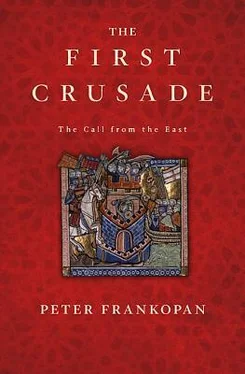Resistance within Jerusalem collapsed immediately. The town’s commander, Iftikhar ad-Dawla, looked to his own safety and cut a deal with the western leaders, handing control of the Holy City over in return for safe transit to the citadel, where he planned to hold out until the vizier of Cairo’s forces arrived. The agreement that he, his wives and selected others would be able to leave the city unharmed was respected by the Crusaders. 15The Muslim commander must nevertheless have worried; the governor of Maarrat an-Numan had made a similar agreement with Bohemond in the spring of 1099, only to be butchered as he left the town. 16
The city of Jerusalem fell to the Crusaders on 15 July 1099. The Latin sources leave little to the imagination in their description of the behavi our of the westerners as they poured into the city: ‘Some of the pagans were mercifully beheaded, others pierced by arrows from the towers, and yet others, tortured for a long time, were burned to death in searing flames. Piles of heads, hands and feet lay in the homes and streets, and men and knights were running to and fro over corpses.’ 17
The slaughter was on a scale which shocked even the most sanguine of eyewitnesses: ‘Almost the whole city was filled with their dead bodies so the survivors dragged the dead ones out in front of the gates and piled them up in mounds as big as houses outside the city gates. No one has ever heard of such a slaughter of pagans, for they were burned on pyres like pyramids and no one save God knows how many of them there are.’ 18
Another author, not present at the time, concurred about the horror of the attack. ‘If you had been there, your feet would have been stained to the ankles in the blood of the slain. What shall I say? None of them were left alive. Neither women nor children were spared.’ 19The accounts of the sack of Jerusalem were dramatic and bleak. But the portentous language and imagery of many of the victors’ accounts were also deliberate – with the Book of Revelation providing a specific reference point to underline the significance of the Christian success. 20
Nevertheless, other sources reveal something of the scenes that accompanied the capture of the city. One horrified Muslim writer claimed that 70,000 were murdered in the al-Aqsa mosque alone, including imams, scholars and righteous men. 21Jews too were massacred as cries of vengeance for Christ’s crucifixion hung thick in the air. The Crusaders seemed not in the mood to celebrate so much as to settle scores. 22
Some visited the Holy Sepulchre to thank God for having delivered them finally to their destination. But for many, there were other priorities. The appetite for loot seemed inexhaustible. The Crusaders had heard rumours that Muslims had swallowed their most precious belongings to prevent them from being looted. ‘How astonishing it would have seemed to you’, Fulcher of Chartres reported, ‘to see our squires and footmen, after they had discovered the trickery of the Saracens, split open the bellies of those they had just slain in order to extract from their intestines the bezants which the Saracens had gulped down their loathsome throats while alive! For the same reason, a few days later, our men made a great heap of corpses and burned them to ashes in order to find more easily the above-mentioned gold.’ 23
Those who had entered Jerusalem seized whatever property they wished; many Crusaders of previously limited means suddenly occupied houses in the most important city in the Christian world. 24Eventually, after two days of bloodshed and chaos, the expedition’s leaders decided to clear corpses from the streets to prevent the spread of disease. And as the bloodlust subsided, the Crusaders became more restrained in their dealings with the city’s inhabitants. One Jewish commentator even preferred the Crusaders to the previous Muslim overlords – at least they were given food and drink by their new masters. 25
Jerusalem was finally restored to Christian hands. It was the culmination of a journey of almost unimaginable ambition, of unprecedented scale and organisation that had seen tens of thousands of men cross Europe and Asia Minor campaigning against all the odds and in astonishingly hostile conditions. The logistics of keeping a substantial force supplied with food and water while maintaining order and discipline had been highly challenging. In terrain that was more gruelling and hotter than these men had experienced before, the Crusaders had attacked many well-defended forts, towns and cities. There was no mistaking the achievement – three of the biggest cities in the eastern Mediterranean, cornerstones of Christianity, had been conquered in the space of two years: Nicaea, Antioch and Jerusalem.
It was the third and last that was the most important to those who had left western Europe in 1096. The capture of Jerusalem was an extraordinary feat, a testimony to the determination, skill and tenacity of the Crusaders. All had endured hardship, tension and fear; many had not made it. It was a time for celebration.
‘With the fall of the city it was rewarding to see the worship of the pilgrims at the Holy Sepulchre, the clapping of hands, the rejoicing and singing of a new song to the Lord’, said Raymond of Aguilers, who was among those present at the fall of the city. ‘Their souls offered to the victorious and triumphant God prayers of praise which they could not explain in words. A new day, new gladness, new and everlasting happiness, and then fulfilment of our toil and love brought forth new words and song for all. This day, which I affirm will be celebrated in centuries to come, changed our grief and struggles into gladness and rejoicing. I further state that this day ended all paganism, confirmed Christianity and restored our faith. “This is the day which the Lord has made; we shall rejoice and be glad in it”, and deservedly because on this day, God shone upon us and blessed us.’ 26
In the aftermath of the capture of Jerusalem, the Crusaders were faced with difficult decisions. How should the city be governed; how should they engage and interact with the local population; what reliance, if any, would they have on Byzantium and the emperor Alexios; how would the city and its new masters be supplied; what opposition were they going to face in future? Steps had to be taken as it dawned on the westerners that they would have to try to ensure that the capture of the city was not a transient success, but the basis of permanent Christian rule.
There was not much time for debate. Jerusalem and the surrounding region needed to be secured quickly, for even as the city was being looted, news came of a huge army bearing down on them from Cairo. As a first move, a week after taking the city, the Crusade’s leaders met and proposed to elect the richest, worthiest and most devout of them as monarch. The establishment of royal government was of course partly a replication of a political system the knights were most familiar with. But there was also a deliberate purpose behind vesting authority in one individual: to avoid the fragmentation and indecision that had plagued the expedition after the capture of Antioch. Raymond of Toulouse was the obvious choice for this role. Yet against the expectations of the Crusaders, Raymond refused; his devout response was that the royal title was suitable only for the Son of God, at least in this most holy of cities. This piety was all very well, but the Crusaders recognised the need for authoritative leadership. If Raymond was not prepared to step up, who else might be suitable to take the role?
Godfrey of Bouillon had also performed well during the Crusade; he had been diligent and reliable throughout, and perhaps most importantly, he had not been divisive. His argument with the emperor in Constantinople about taking the oath showed that he was prepared to stand his ground when necessary, and his apparent intention to remain in the Holy Land after the expedition also counted strongly in his favour. Godfrey did not need to be asked twice. Sensitive, however, to Raymond’s objections to the royal title of king, he was shrewd enough to find a way to get round the issue. On 22 July 1099, Godfrey was named as Advocate of the Holy Sepulchre. It was up to him to turn the western conquerors into settlers.
Читать дальше











